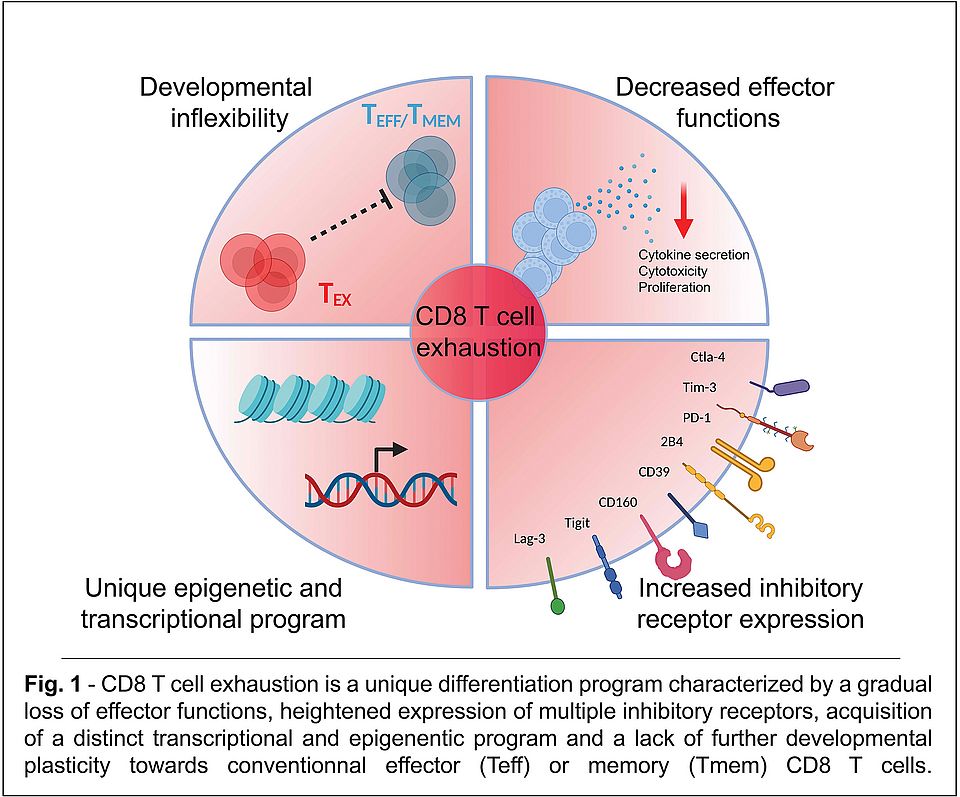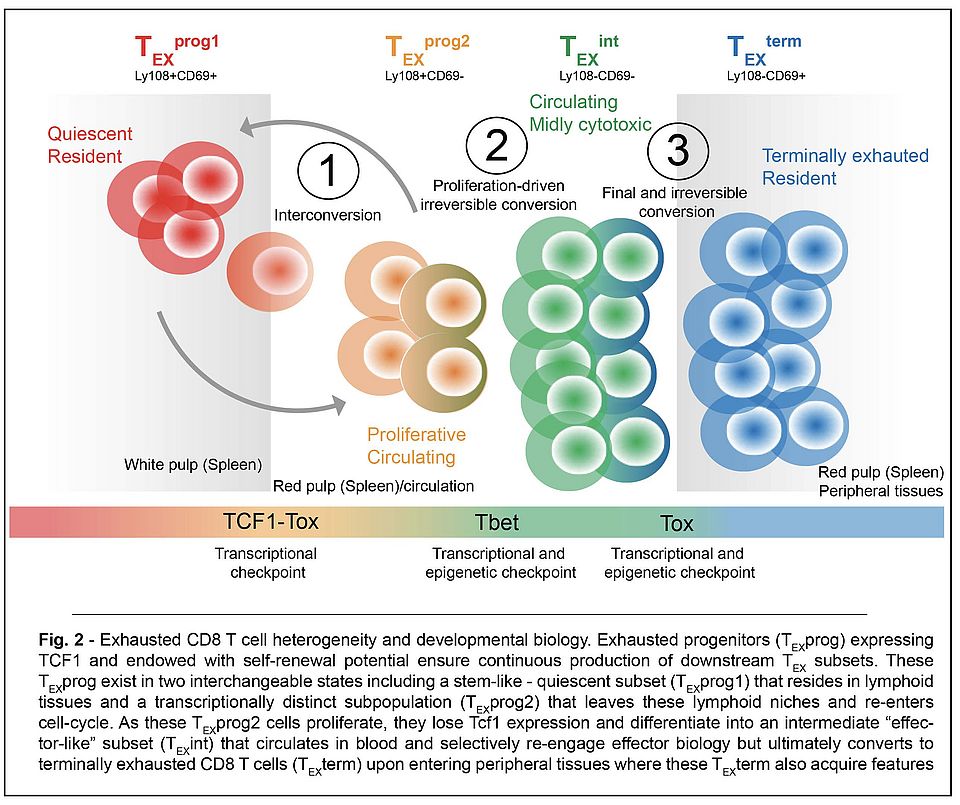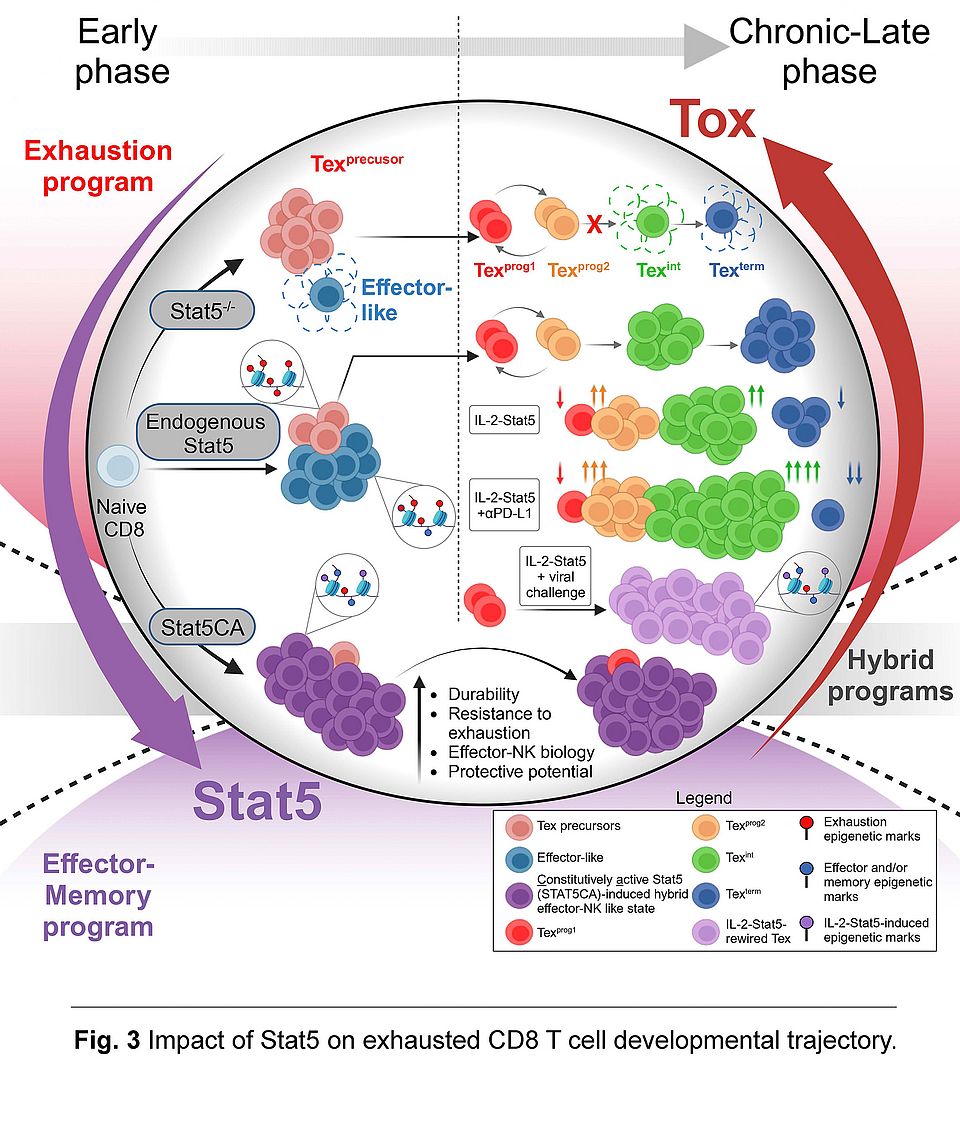Immunobiology and Immunotherapy
CD8 T cell exhaustion . Cytokines . PD-1 blockade . Cancer immunotherapy . Single-cell . CRISPR
Uncovering new strategies to manipulate exhausted CD8 T cells and improve cancer immunotherapy
Exhaustion of CD8 T cells often occurs during chronic viral infections (HIV, HCV) and cancer.1 This unique development program gradually deprives CD8 T cells from their main effector functions (Fig. 1) and is a major cause of anti-cancer immunotherapy failure. Targeting checkpoint molecules expressed at the surface of TEX cells such as the programmed-cell death-1 (PD-1) receptor, can revitalize exhausted CD8 T cells (TEX) and be curative. However, PD-1-based therapy does not relieve TEX from their epigenetically programmed exhaustion state, which likely explains the lack of durable benefits in many patients.2,3 Developing complementary approaches to PD-1 therapy has become a major challenge. Yet, an incomplete understanding of the exhaustion process has hindered the design of relevant therapeutic intervention.
Recent work re-defining the heterogeneity and developmental biology of TEX cells has provided new insights of therapeutic importance. Distinct subsets of TEX cells were identified that acquire unique biology and cooperate in a complex developmental hierarchy (Fig. 2). Resolving this biology notably revealed that the benefits associated with PD-1 therapy are likely mediated by a specific subset of TEX cells namely TEX intermediate (TEXint). Indeed, these TEXint cells selectively expand following therapy and partially escape the functional constraints of exhaustion by temporally re-engaging some functional and epigenetic features of bone fide effector cells (Beltra et al., Immunity 2020).4-6 These observations not only depicted the precise cellular dynamic underlying TEX responses to PD-1 blockade (i.e. temporal expansion of TEXint) but also pointed out previously unappreciated flexibility in the epigenetic program of exhaustion that could be exploited therapeutically.
Indeed, subsequent work identified the transcription factor Stat5 as a key axis for TEXint cell formation and a major drive of the effector biology in this subset. Temporal re-enforcement of Stat5 activity in TEX cells strongly synergized with PD-1 blockade at expanding TEXint cells and partially reprogrammed the epigenetic landscape of TEX cells to rewire these cells towards more durably protective states with superior anti-tumor potential (Fig. 3) (Beltra et al., Immunity 2023).7 This work was proof of concept that exploiting a deep understanding of TEX cell developmental biology will reveal new opportunities to improve cancer immunotherapy.
Therefore, the primary research interests of our group are centered on the identification and characterization of new pathways regulating T cell exhaustion. By leveraging key immunological tools, relevant murine models as well as next generation sequencing approaches and genetic perturbation tools, our group works on providing a better understanding of the exhaustion process with the aim of creating new opportunities to advance next-generation anti-cancer immunotherapies.
Connection to Clinical Practice
The discovery of immune checkpoints (e.g. programmed cell death 1 receptor [PD-1] and the cytotoxic T-lymphocyte associated antigen 4 [CTLA-4] - Nobel prize 2018 to James Allison and Tasuku Honjo) has revolutionized the field of clinical oncology. First introduced into the clinic more than a decade ago, these agents are now first or second line treatment, alone or in combination in more than 50 different cancer types. However, despite many clinical successes, treatment with checkpoint inhibitors still fails at eliciting long-term immune protection in a majority of patients. Mechanisms of innate and acquired resistance to checkpoint blockade therapy coupled to the inability of these approaches (e.g. PD-1 blockade) at reversing the process of CD8 T cell exhaustion represent therapeutic challenges that need to be addressed for unleashing the full potential of checkpoint blockade therapy. However, our lack of understanding over the biological processes underlying these clinical limitations to checkpoint therapy has hindered the design of relevant therapeutic interventions. For instance, while our understanding of the CD8 T cell exhaustion process has significantly improved over the last years, therapeutic strategies capable of efficiently reversing this process are still lacking. This research is much needed to complement PD-1-based therapy and improve current cancer immunotherapies for which T-cell exhaustion remains a central limitation (CAR-T, adoptive cell therapy). Depicting the complex process of CD8 T cell exhaustion and identifying innovative strategies to reverse this process is, therefore, a major focus of our research group.



1 McLane, L. M., Abdel-Hakeem, M. S. & Wherry, E. J. CD8 T Cell Exhaustion During Chronic Viral Infection and Cancer. Annu Rev Immunol 37, 457-495 (2019).
2 Pauken, K. E. et al. Epigenetic stability of exhausted T cells limits durability of reinvigoration by PD-1 blockade. Science (2016).
3 Huang, A. C. et al. T-cell invigoration to tumour burden ratio associated with anti-PD-1 response. Nature 545, 60-65 (2017).
4 Beltra, J. C. et al. Developmental Relationships of Four Exhausted CD8(+) T Cell Subsets Reveals Underlying Transcriptional and Epigenetic Landscape Control Mechanisms. Immunity 52, 825-841 e828 (2020).
5 Hudson, W. H. et al. Proliferating Transitory T Cells with an Effector-like Transcriptional Signature Emerge from PD-1(+) Stem-like CD8(+) T Cells during Chronic Infection. Immunity 51, 1043-1058 e1044 (2019).
6 Zander, R. et al. CD4(+) T Cell Help Is Required for the Formation of a Cytolytic CD8(+) T Cell Subset that Protects against Chronic Infection and Cancer. Immunity 51, 1028-1042 e1024 (2019).
7 Beltra, J. C. et al. Stat5 opposes the transcription factor Tox and rewires exhausted CD8(+) T cells toward durable effector-like states during chronic antigen exposure. Immunity 56, 2699-2718 e2611 (2023).
